| Data Images |
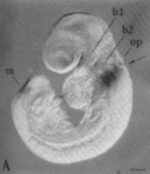 |
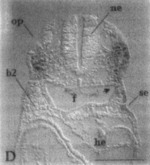 |
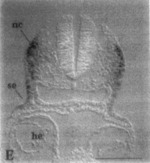 |
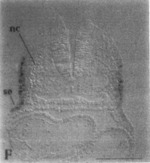 |
|
| Fig8A
[doi:10.1016/0925-4773(94)90078-7] Copyright: Reprinted with permission from
Elsevier from Mech Dev 46(2): 87-100, Ruiz JC; Robertson EJ , The
expression of the receptor-protein tyrosine kinase gene, eck, is highly
restricted during early mouse development. Copyright 1994. [PMID:7918100] |
Fig8D
[doi:10.1016/0925-4773(94)90078-7] Copyright: Reprinted with permission from
Elsevier from Mech Dev 46(2): 87-100, Ruiz JC; Robertson EJ , The
expression of the receptor-protein tyrosine kinase gene, eck, is highly
restricted during early mouse development. Copyright 1994. [PMID:7918100] |
Fig8E
[doi:10.1016/0925-4773(94)90078-7] Copyright: Reprinted with permission from
Elsevier from Mech Dev 46(2): 87-100, Ruiz JC; Robertson EJ , The
expression of the receptor-protein tyrosine kinase gene, eck, is highly
restricted during early mouse development. Copyright 1994. [PMID:7918100] |
Fig8F
[doi:10.1016/0925-4773(94)90078-7] Copyright: Reprinted with permission from
Elsevier from Mech Dev 46(2): 87-100, Ruiz JC; Robertson EJ , The
expression of the receptor-protein tyrosine kinase gene, eck, is highly
restricted during early mouse development. Copyright 1994. [PMID:7918100] |
|
|
|
| Expression pattern clarity: |
 |
| Find spatially similar wholemount expression patterns: |
 |
|
|
| Notes: |
|
A - wholemount stained embryo. D-F, 10 um tissue sections located 30 um, 80 um, and 130 um, respectively, from the rostral boundary of eck expression (approximate plane of section is denoted by an arrow in A).
Image annotations: bl, branchial arch 1; b2, branchial arch 2; b3, branchial arch 3; cn, caudal neuropore: he, heart: f, foregut; ne, neural epithelium; nc, neural crest; op, otic pit; rp, roof plate; se, surface ectoderm; and tb, tail bud. The arrowhead denotes the second branchial pouch. |
|
| Expression Pattern Description |
| Spatial Annotation: |
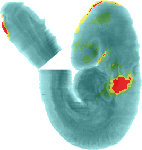 | | | | | Annotation colour key:
 |
strong |
 |
moderate |
 |
weak |
 |
possible |
 |
not detected |
|
| wholemount mapping | | | | |
| Download individual expression domains: |
|
| Download all expression domains: |
EMAGE:5265_all_domains.zip |
| Find spatially similar wholemount expression patterns: |
 |
| Morphological match to the template: |
 |
|
| Text Annotation: |
| Structure | Level | Pattern | Notes |
|---|
| caudal neuropore |
 |
detected |
| | After the incorporation of the node into the caudal neuropore, eck mRNA expression is upredgulated in the dorsal region. |
| 3rd branchial arch |
 |
detected |
| | eck is expressed in lateral mesenchyme cells adjacent to rhombomere 6 and which appear to form a stream of cells extending ventrally toward the developing 3rd branchial arch. |
| future hindbrain |
 |
not detected |
| homogeneous | |
| head mesenchyme |
 |
detected |
| regional | eck is expressed in lateral mesenchyme cells adjacent to rhombomere 6 and which appear to form a stream of cells extending ventrally toward the developing 3rd branchial arch. Moreover, only cells immediately adjacent to the surface ectoderm express eck. |
| rhombomere 06 |
 |
not detected |
| homogeneous | |
| surface ectoderm |
 |
detected |
| regional | Detected in surface ectoderm overlying the 3rd branchial arch. |
|
| Annotation Validation: |
EMAGE Editor |
|
| Detection Reagent |
| Type: | in situ hybridisation probe |
| Identifier: | Epha2 probeA |
| Entity Detected: | Epha2, Eph receptor A2 ( MGI:95278) |
| Notes: | The Epha2 (eck) probe used in this study by Ruiz & Robertson, 1994 [PMID:7918100] was generated "from pceck2", a full-length cDNA clone which was isolated from an 8.5-dpc embryonic cDNA library.
Editors note: is is unclear from the authors description if the probe used for WMISH was synthesized from the entire insert of pceck (which is shown in Fig1 therein and U07634) or a portion of it, as the probe used in this study for radioactive section ISH was generated from a subclone of pceck2 (pNH2eck (nt1-1890)). |
| Chemistry: | RNA |
| Strand: | antisense |
| Label: | digoxigenin |
|
| Specimen |
| Organism: | mouse |
| Age: | 9.0 dpc |
| Theiler Stage: | TS14 |
| Mutations: | none (wild-type) |
| Preparation: | wholemount |
|
| Procedures |
| Fixation: | 4% paraformaldehyde |
| Staining procedure: | alkaline phosphatase + unspecified |
|
| General Information |
| Authors: | Ruiz JC; Robertson EJ, 1994 [PMID:7918100] , Indexed and Spatially Mapped by EMAGE. |
| Submitted by: | EMAGE EDITOR, Institute of Genetics and Molecular Medicine, Western General Hospital, Crewe Road, Edinburgh, UK EH4 2XU |
| Experiment type: | non-screen |
| References: | [ doi:10.1016/0925-4773(94)90078-7] [ PMID:7918100] Ruiz JC, Robertson EJ 1994 The expression of the receptor-protein tyrosine kinase gene, eck, is highly restricted during early mouse development. Mech Dev (46):87-100 |
| Links: | Ensembl same gene |
| | Allen Brain Atlas same gene |
| | BioGPS same gene |
| | International Mouse Knockout Project Status same gene |
| | GEISHA Chicken ISH Database same gene |
| | EMBL-EBI Gene Expression Atlas same gene |
| | BrainStars same gene |
| | ViBrism same gene |
| Data Source |  |
|
 icon to keep this page displayed.)
icon to keep this page displayed.)
 icon to keep this page displayed.)
icon to keep this page displayed.)